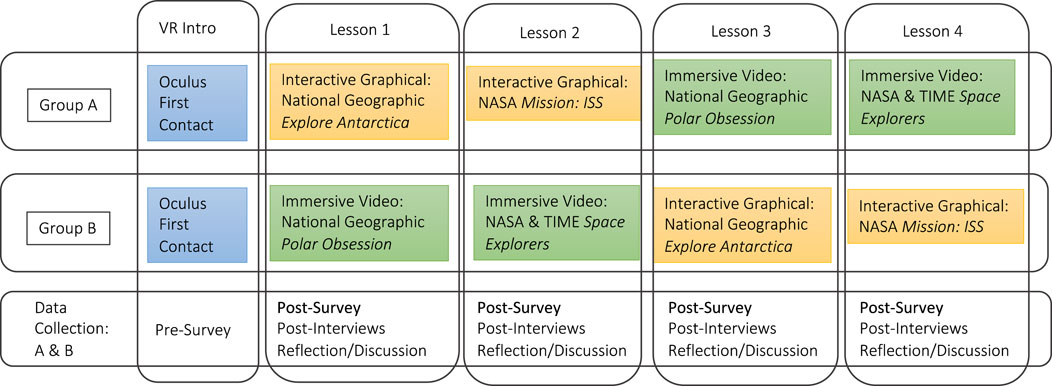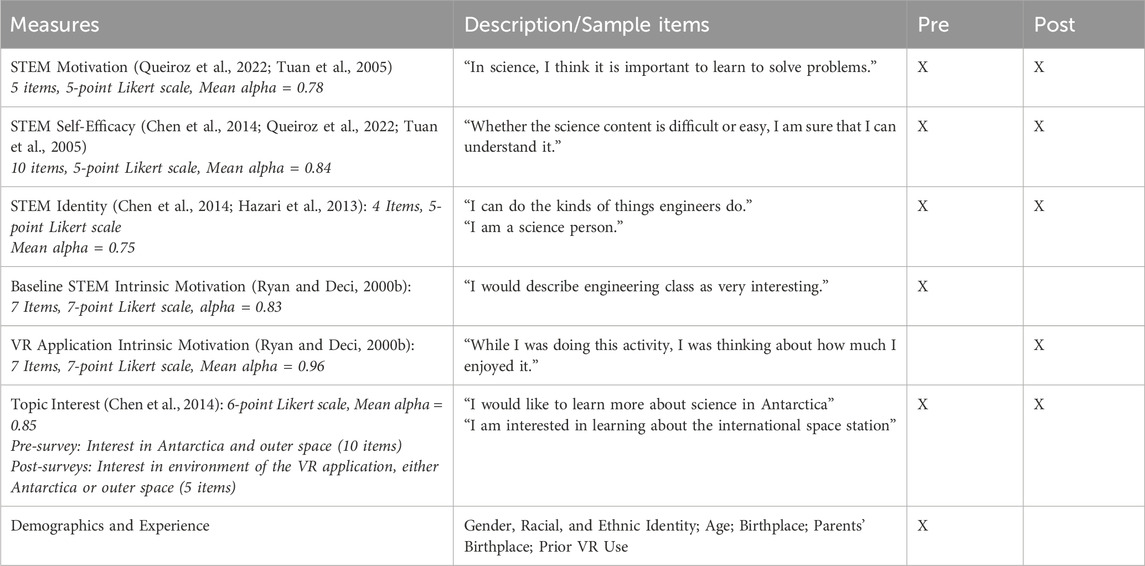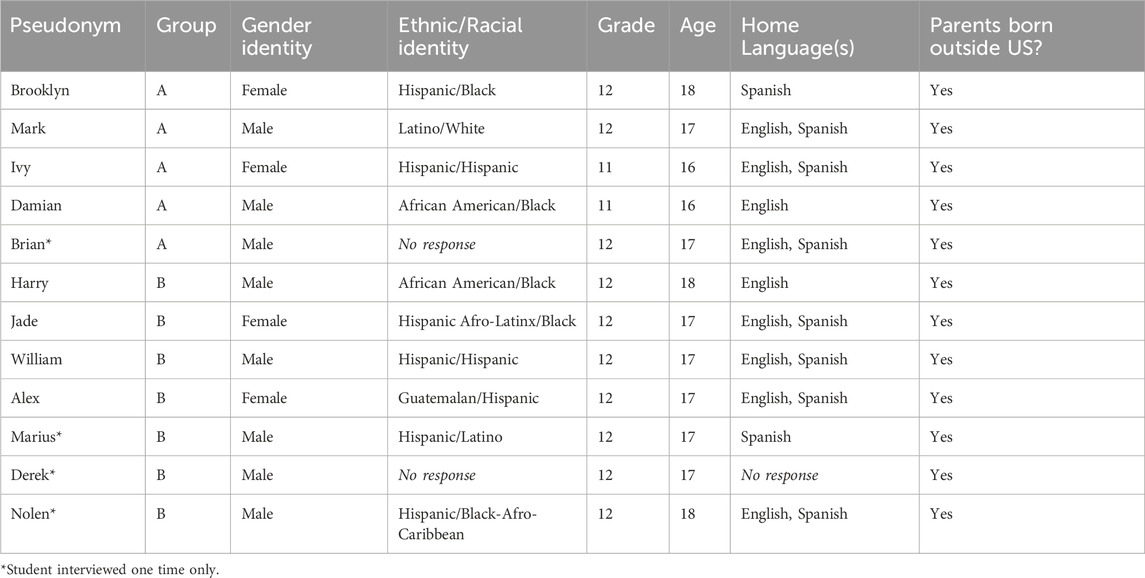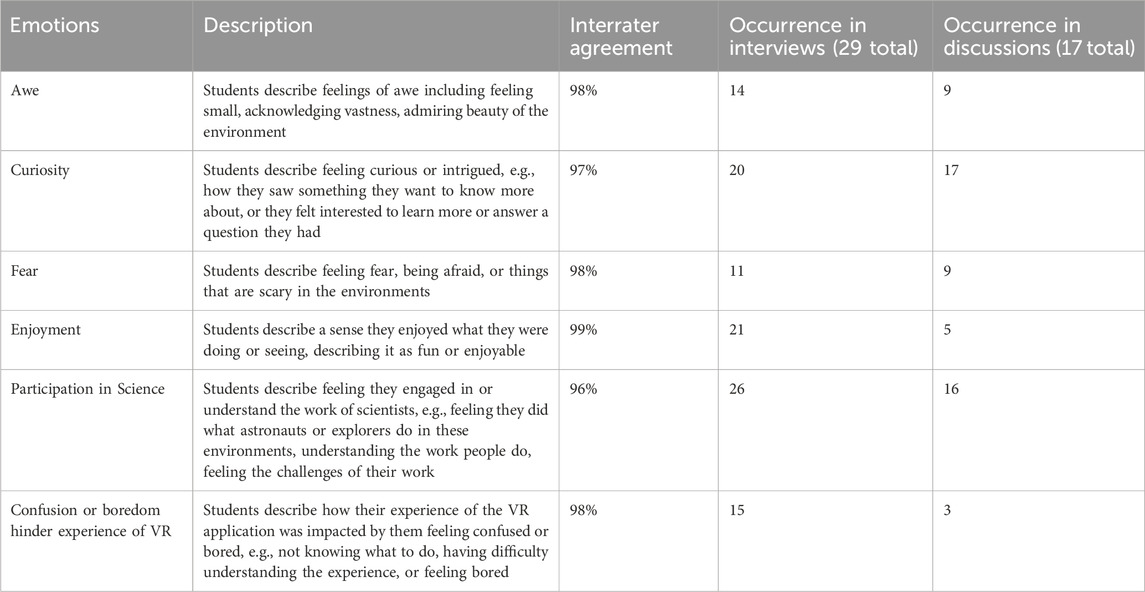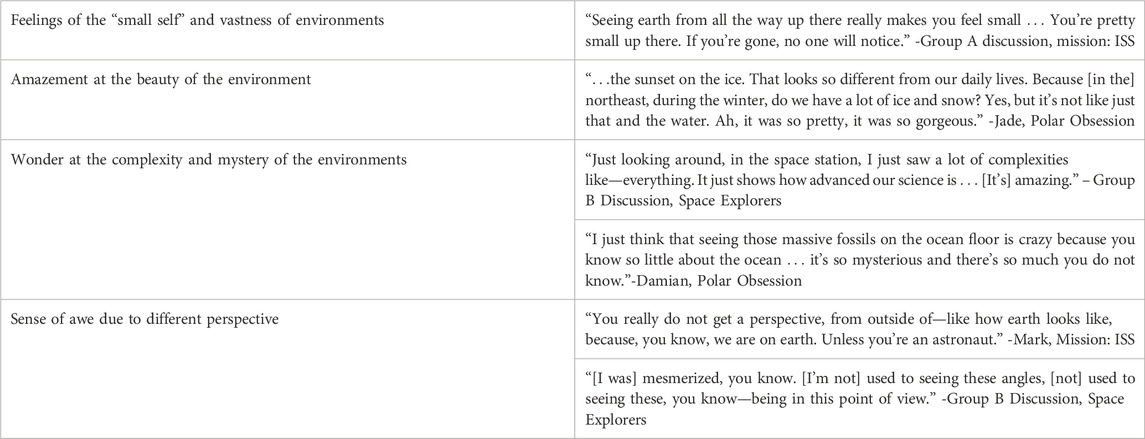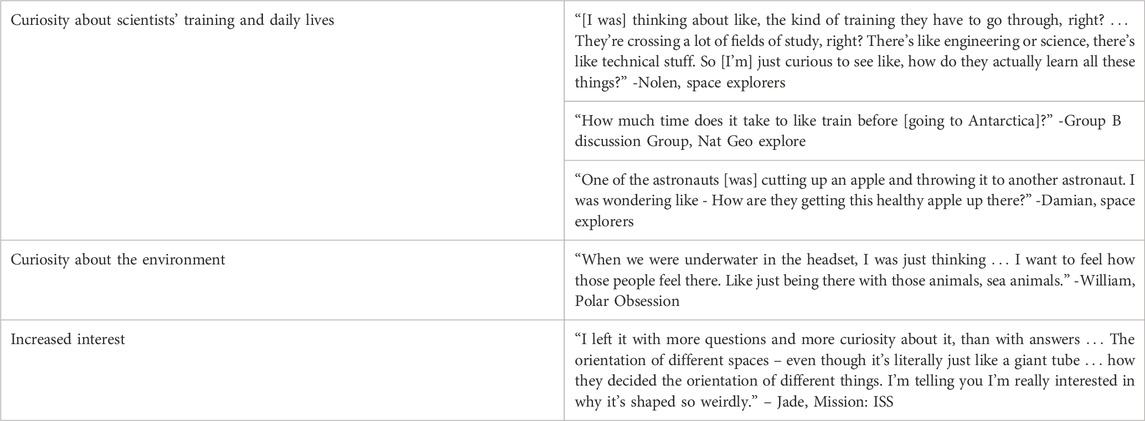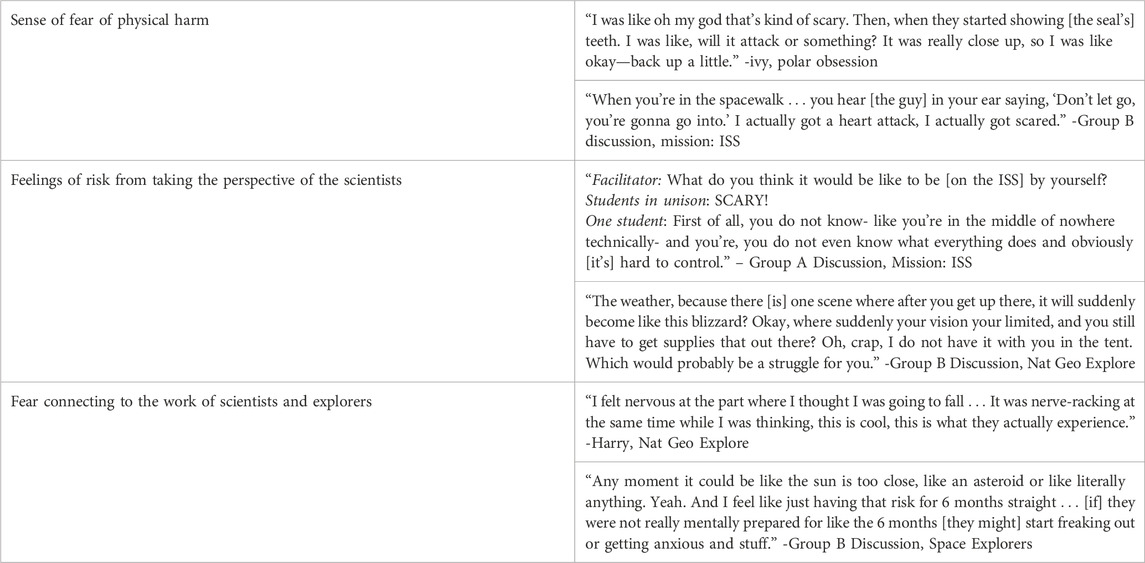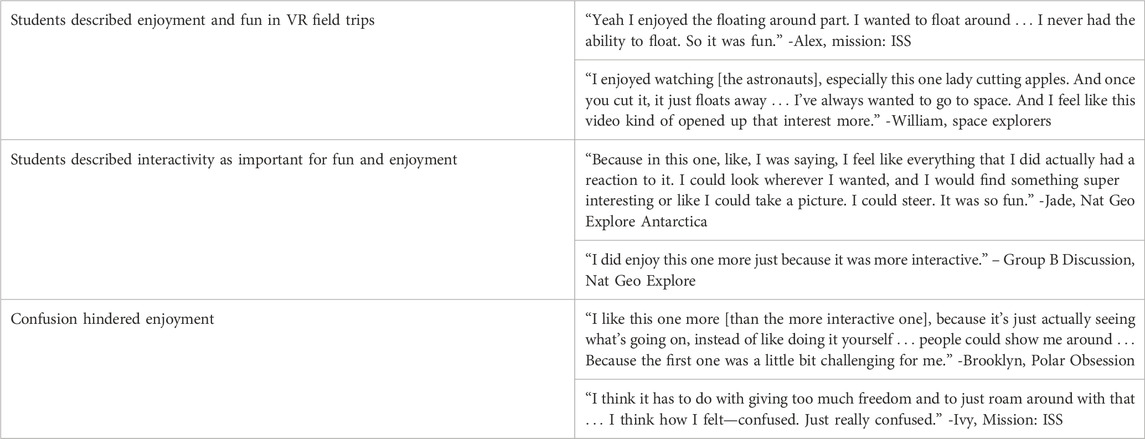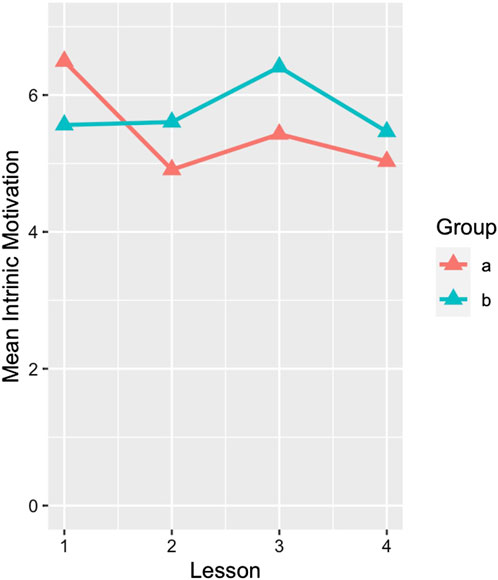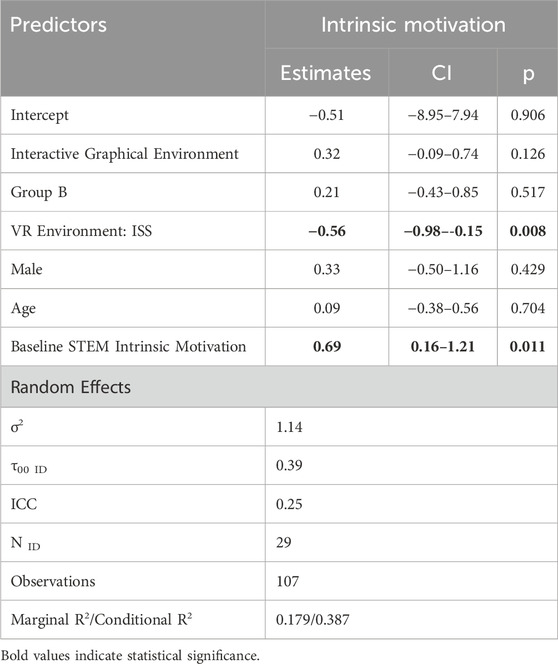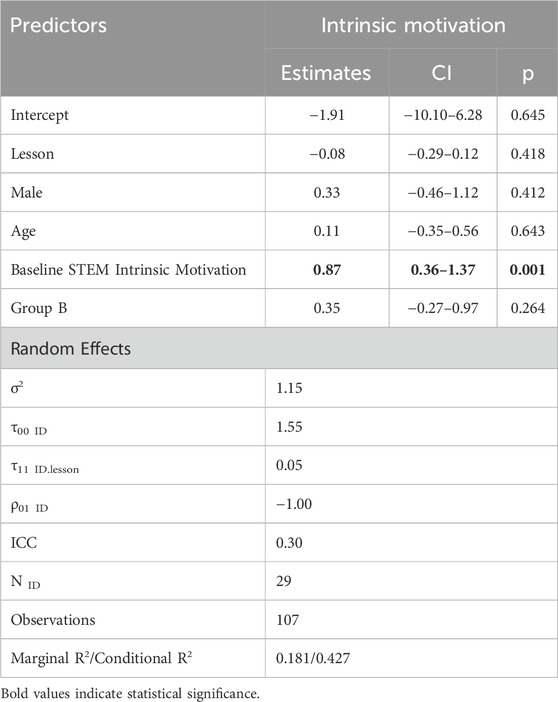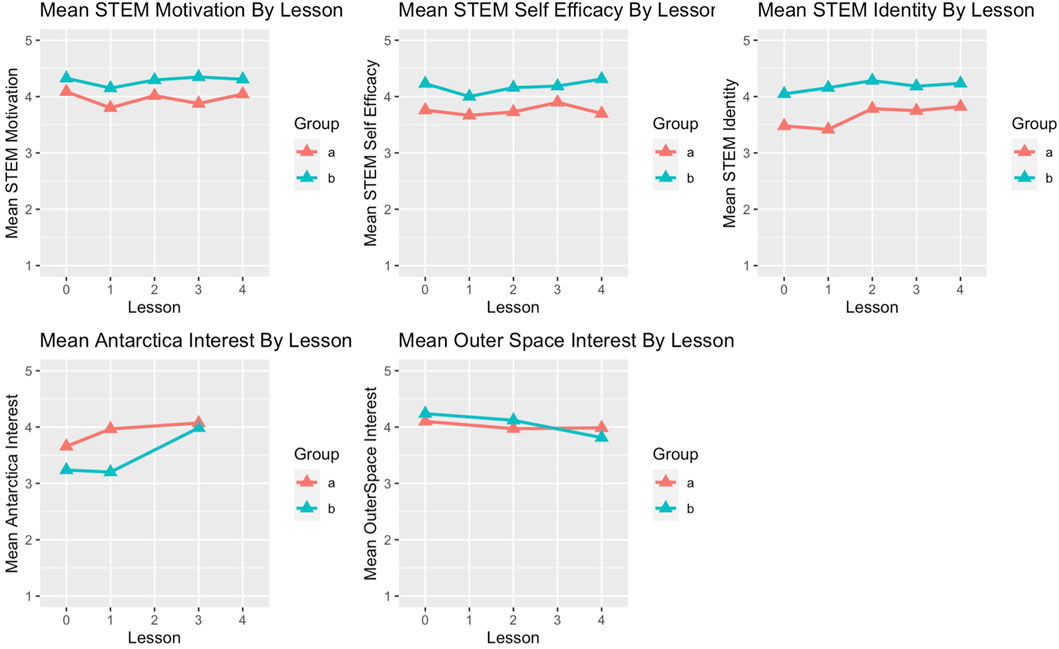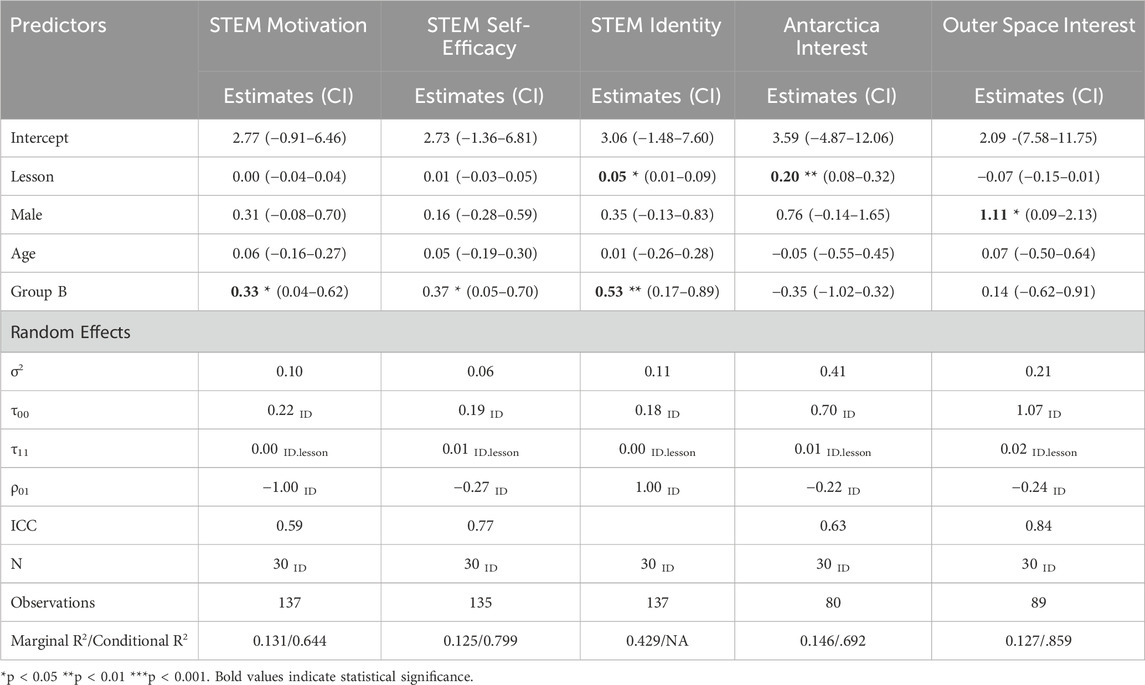- 1 Department of Art + Design, Northeastern University, Boston, MA, United States
- 2 Department of Communication Studies, Northeastern University, Boston, MA, United States
While emotions and motivation are key to the process of learning, typical classroom instruction lacks engagement of such affective dimensions of learning. Virtual reality (VR) technologies are powerful tools for engendering emotions and increasing intrinsic motivation that may enable science, technology, engineering, and math (STEM) learning that enhances learners’ affect. This study explored whether VR field trip experiences can be enabling environments for emotions and motivation in classroom learning. Thirty high school engineering students used VR experiences over four lessons, and mixed methods of surveys and interviews assessed what emotions they felt, the degree to which they were intrinsically motivated when learning with VR, and whether participating in the VR field trips changed their longer-term beliefs and motivation toward STEM. The results point to VR as an enabler of powerful emotions and high levels of intrinsic motivation, but that it may not have an effect on longer-term beliefs and attitudes.
Introduction
Emotion and motivation are core to the process of science, technology, engineering and math (STEM) learning, but typical school-based instruction fails to engage these aspects of the learning process. Virtual reality (VR) is an increasingly accessible instructional tool that can engage powerful emotions, facilitate identity exploration, and foster motivation to learn. Because VR learning environments feel real and allow learners to interact and role play, they can be useful for bringing more situated learning opportunities into classrooms, rather than requiring taking learning outside the classroom (Dede, 2009; Johnson-Glenberg, 2018; Makransky and Petersen, 2021). One such example is field trips, an educational activity that fosters intrinsic motivation to learn and exposes learners to the practices of professionals (Behrendt and Franklin, 2014; Csikszentmihalyi and Hermanson, 1995; DeWitt and Storksdieck, 2008), but which VR can help to facilitate in the classroom and to inaccessible locations.
This study explored whether VR can enable important emotional and motivational dimensions of STEM learning that are often lacking in classroom instruction. These are referred to as affective dimensions of learning which include emotional, motivational, social, and moral constructs that facilitate and are intertwined with cognitive dimensions of learning (Chaffar and Frasson, 2012; Martin and Reigeluth, 2013). In particular, there is growing recognition of the role emotions like curiosity play in the process of scientific discovery that are also important for learning, referred to as epistemic emotions as they relate to knowledge generation and acquisition, Thirty high school students participated in four VR field trips on Antarctica and the International Space Station (ISS). The study used two types of VR media, immersive videos and videogame-like interactive graphical environments, allowing for comparisons of different features in VR such as interactivity on students’ affective responses. Using a concurrent mixed-method design, the study allowed students’ emotional responses to emerge from interviews, discussions, and observations, and surveys tracked students’ motivation and interest over time.
Research questions
This study explored how the affordances of VR that give learners enhanced presence in a virtual space and increased agency via embodied interactivity enable affective dimensions of learning. Specifically, the study asks:
• What emotions do high school STEM students experience when using VR field trips, and how do they describe features of the VR that engender them? How do they describe emotions related to their learning of STEM practices and professionals?
• To what extent and how do high school STEM students find VR field trips intrinsically motivating? Do different types of VR impact their intrinsic motivation? Does their intrinsic motivation change over time?
• Do learners’ STEM motivation, self-efficacy, identity, or their topic interest change over time as they engage with VR field trips?
Background
Affective dimensions of STEM learning
Science has typically aimed to divorce objective reasoning from subjective feeling (Alsop and Watts, 2003, p. 1044). However, research in neuroscience, cognitive science, and learning challenge the assertion that thinking can be understood as something purely in the head akin to the computations run by computer software (Lakoff, 2012). Damasio (1994) drew on extensive neurobiological research of patients suffering brain damage to show how emotions are fundamental to cognition, including decision-making, memory, and attention. Immordino-Yang and Damasio (2007) applied this neurobiological evidence to argue that “we feel, therefore we learn,” encouraging an approach to education that accounts for the whole person, including how learning and cognition are inextricable from emotions, bodies, and contexts.
In STEM education, there has also been increasing recognition of the importance of such emotional dimensions of learning. Jaber and Hammer (2016) described how the Next-Generation Science Standards’ (NGSS), which guide STEM curricula across the United States, focus on connecting science learning to scientific practice requires attention to the affective dimensions of inquiry, incorporating emotion in understanding what causes students to engage in scientific pursuits. Epistemic emotions refer to those engaged in scientific practice, including joy and awe in the process of scientific discovery, curiosity that motivates inquiry, and the discomfort or frustration that comes with the challenge of solving problems (Cuzzolino, 2021; Jaber and Hammer, 2016; Piff et al., 2015).
In addition to these emotions learners feel when engaging in science, motivational constructs typically refer to more sustained beliefs, attitudes and interests that drive the learning process. Research also identifies these as key for STEM learning, for example, in how motivational beliefs affect the process of conceptual change (Pintrich et al., 1993; Zusho et al., 2003). Motivation is multidimensional and can be considered an umbrella term for the drivers of learning that determine what activities a learner will engage in and how they persist through them, such as how people pursue learning that intrinsically motivates them, how they weigh expected outcomes with effort, and what goals they aim to achieve (Eccles and Wigfield, 2020; Ryan and Deci, 2020; Urdan and Kaplan, 2020). Motivational dimensions also include learners’ beliefs, such as self-efficacy, or their belief in their own capabilities (Bandura, 1977). In STEM education, identity is also an important construct in motivational dimensions, as identifying with and a sense of belonging to STEM fields affects learners’ choice and persistence in STEM education (Simpson and Bouhafa, 2020). Identifying with STEM includes considering whether the learner feels like “a science person” (Hazari et al., 2013).
Emotional and motivational dimensions of learning are closely related and are both part of the affective domain of learning. For example, physiological states such as emotions are a driver of a person’s self-efficacy beliefs (Bandura, 1977). Similarly, enjoyment is a core element of intrinsic motivation, the process of engaging in learning activities for pleasure (Ryan and Deci, 2000a). In this study, dimensions of the affective domain are operationalized by considering the responses learners have during and immediately following a learning experience versus more deeply held beliefs, attitudes, and interests not related directly to the experience itself. For example, intrinsic motivation measures refer to enjoyment of the learning experience itself while STEM motivation measured more general feelings about STEM learning in the long-term.
VR and affective dimensions of learning
VR is a powerful tool for evoking emotions and increasing motivation to learn. Studies of VR outside of educational settings have found it can have a powerful impact on users’ emotions (Markowitz and Bailenson, 2021), including epistemic emotions related to science. For example, Chirico et al. (2017) found that 360-degree videos evoked a strong sense of awe indicated by both self-report and physiological measures, connecting emotional responses in VR to embodied visceral reactions. Urban (2022) found that 360-degree videos evoked participants’ sense of awe and subsequently their curiosity about the environments, particularly by suggesting mysteries about the natural phenomena during the video. In other studies, VR has been used to induce joy (Felnhofer et al., 2015) and helped people face trauma and phobias by eliciting fear (Parsons and Rizzo, 2008). These can be important responses in learning contexts, helping people reduce anxieties related to learning skills (Aymerich-Franch et al., 2014; McGivney et al., 2023). This has led to an interest in emotional design in VR learning environments, including how to design an immersive learning experience to enhance positive emotions (Shao et al., 2024).
VR has also been shown to be an effective way to enhance learners’ motivation. While studies tend to find mixed results for VR’s impact on learning outcomes like content retention, studies do find that learners feel more motivated when using VR than other media (Hamilton et al., 2021; Jensen and Konradsen, 2018; Wu et al., 2020). For example, Parong and Mayer (2021) found that learners using a VR application reported higher motivation and interest but lower content retention than those using a slide show, and Makransky et al. (2019) and Ochs and Sonderegger (2022) found VR increased motivation via heightened presence over a PC but not learning outcomes. Research also shows how VR can influence people’s sense of self and identity, and studies have shown that gender stereotypes and culturally-defined sense of self can impact learners’ motivation and subsequent learning in VR (McGivney, 2025; Pimentel and Kalyanaraman, 2021; Ratan et al., 2021). Studies have also found that VR experiences increase learners’ self-efficacy (Queiroz et al., 2022).
VR design and implementation
While research on learning with VR has increased in recent years, most studies are “hardware focused,” asking whether people learn more when using VR compared to a different device (Jensen and Konradsen, 2018), are conducted in labs rather than classrooms (Southgate, 2020), and assess impact on learning after a brief experience (Wu et al., 2020). This leaves many open questions about learning with VR including how experiences can be designed to enhance learning and how learners will respond as the novelty wanes over time. Studies have pointed to the importance of the design of interactivity within VR learning environments beyond looking at the device itself (Bagher et al., 2021). And while some have hypothesized increases in learning from VR are due to its novelty, studies that look at multiple uses of VR over time have not found that learning decreases as learners get used to the technology (Han et al., 2023; Huang et al., 2021). These studies point to a need for more research on how VR can enable different learning outcomes based on the design of the media and how it is implemented in classrooms.
Materials and methods
Participants
This study was conducted at an urban public charter high school in a low-income city in the Boston area, serving students of whom 67% are classified as low-income and 76% as high needs. Participating students were from two high school engineering classes for a total of 30 11th and 12th grade students. To an open-ended survey question about their gender identity, five students identified as female/girl/woman and 25 as male/boy/man, no students identified as non-binary or other genders. 28 students were second-generation Americans whose parents were born outside the U.S., and 1 student was first-generation American, born outside the U.S. 23 were from Latin America and the Caribbean, 5 from Africa, and 1 from Europe. All students (and their parent or guardian if under 18) consented to the study; they were informed that participation in the study was not required to participate in the VR field trips. This study was approved by the [Blinded] Institutional Review Board.
Study design
This study employed design-based research to both develop lessons utilizing VR field trips and build an understanding of learners’ experiences with them in an authentic classroom environment (Barab and Squire, 2004; Brown, 1992). The study was designed to provide every student a meaningful and equitable learning experience across four lessons, while altering the order of using different types of VR experiences to answer research questions about their impact on students. Figure 1 depicts the study design, in which students were divided into two groups of 15 students. Group A used the interactive graphical environments in lessons 1 and 2, and used immersive videos in lessons 3 and 4, students in Group B used them in the reverse order.
Data collection
A concurrent mixed method design was used (Creswell and Plano Clark, 2018) to collect survey and interview data longitudinally across the four lessons. Table 1 describes the instruments used for the pre- and post-surveys. Items were adapted from scales and measures used in prior studies of immersive technologies in STEM education. The measures have been used and validated in studies of VR and other immersive virtual learning environments: See Chen et al. (2014) and Chen et al. (2016) for detailed descriptions of the interest, self-efficacy, and identity measures used in the context of an immersive simulation in longitudinal models, Quieroz et al. (2022) for descriptions of self-efficacy and motivation in a VR STEM education classroom activity, and a validation of the widely used intrinsic motivation inventory with a VR learning experience in Makransky et al. (2020). The contexts and population of this study align well with these prior validations of affective dimensions measures. Their coherence was estimated for each wave of data collected using Cronbach’s alpha (Cronbach, 1951): its mean across lessons is reported in Table 1. Intrinsic motivation was measured at the baseline related to students’ enjoyment of STEM classes, and in post-surveys related to enjoyment of the VR experience.
Measures of STEM motivation referred to students’ general beliefs about studying STEM and science not directly related to the VR experiences, including whether they think learning STEM is important to stimulate their thinking, satisfy curiosity, and to use it in their daily lives. Self-efficacy referred to their general beliefs about their capability to do well in STEM, and identity about whether they generally identify as scientists and engineers. Along with topic interest, these measures are used to assess the longer-term changes in student affect and represent more deeply held beliefs and attitudes, rather than immediate reactions to the VR experiences themselves. On the other hand, the interest/enjoyment subscale of the intrinsic motivation inventory measured their feelings while using the VR, a more immediate and short-term affective outcome.
Table 2 shows the mean levels of each measure taken at the baseline related to students’ motivation and interest. The two groups differed significantly in their average reported self-efficacy and identity: students in Group B reported higher levels. Despite random assignment, the two groups may not be equivalent.
Interviews were conducted with the same 8 students following each lesson, who were purposively sampled to represent a mix of genders, STEM interest, and membership in Group A or B. An additional 4 students were interviewed when researchers had time for additional interviews. Table 3 describes the interview participants. Interviews were semi-structured and asked students to discuss what they learned, whether the VR experience related to their own interests, and how they felt while using the VR application. Small group discussions were also recorded and analyzed as qualitative data. Interviewees are referred to by pseudonyms. Student names were not recorded as part of discussions, and they are referred to only by the discussion group.
Lesson design and implementation
The goal of the lessons was to help students develop the skill and disposition of problem-finding and articulation, which is the first step of the engineering design process and a persistent challenge in engineering education (Lucas et al., 2014). The lessons were based on an experiential learning framework (Dede et al., 2017; Kolb et al., 2014) in which students engaged in planning (a pre-work activity about the environment), acting (participating in a VR experience), and reflecting (written reflections and small group discussions). Students used applications about the International Space Station and Antarctica and were asked to write about problems they saw that engineering could solve.
Four VR experiences were used that are available via the Oculus Store and YouTube, depicted in Figure 2. Two applications are interactive graphical environments and two are immersive videos. All experiences were pre-loaded onto Oculus Quest 1 headsets to work offline, ensuring they did not rely on the school’s Wi-Fi. In the interactive graphical environments, students could move themselves through the environment by moving their bodies or teleporting via controllers. They could pick up and move objects, and they were given tasks and missions such as photographing wildlife in Antarctica or conducting a spacewalk on the ISS. In immersive videos, students could move their heads and the environment updated to their view as they watched a narrative story and observed people working in the environment. Students using an interactive graphical environment were given a 7-foot-square area to move around in, while students using immersive videos used a stationary boundary. Students in the latter condition were asked to stand but allowed to sit if they requested to. See Figure 2 for a depiction of the implementation.
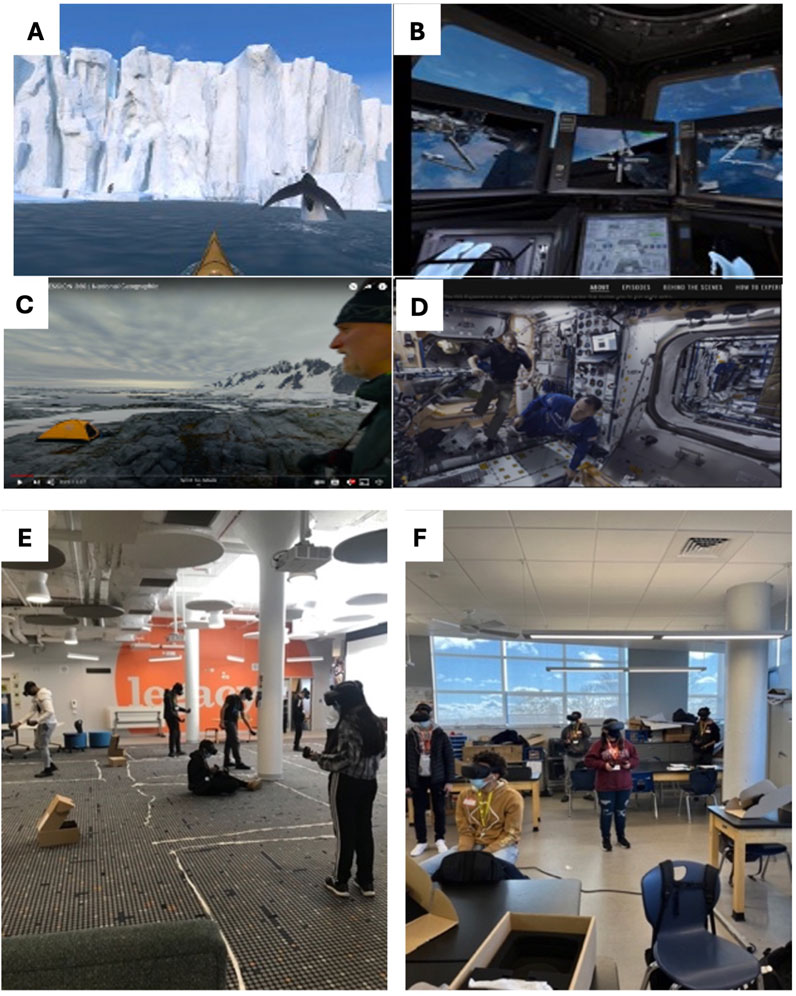
Figure 2. VR Applications and Classroom Implementation. Top: Interactive Graphical Environments. (A) National Geographic Explore [National Geographic] and (B) Mission: ISS [Magnopus and NASA]. Middle: Immersive Videos. (C) Polar Obsession [National Geographic Society] and (D) Space Explorers [Felix and Paul]. Bottom: Classroom implementation. (E) Interactive graphical environment. (F) Immersive video.
Analysis
Quantitative and qualitative data were analyzed separately and integrated to triangulate and explain findings across the data sources. The first set of research questions on what emotions students felt and how they described emotions in relation to their learning were answered using qualitative data, allowing themes to emerge and focusing on how students described the ways they felt while using VR, without an integration of quantitative data. The second set of research questions related to intrinsic motivation were analyzed concurrently, where qualitative data was used to explain quantitative findings and identify areas of convergence or divergence between the data sets. For the final set of questions on longer-term outcomes were primarily analyzed with quantitative data, and qualitative data was used to provide additional context or explanation for the results. The combination of the two data sources allowed for rich interview data from a subset of students while also capturing every student’s experience in a standardized way with quantitative data.
Quantitative analysis
A random intercept model estimated predictors of intrinsic motivation, including VR type, the VR environment (Antarctica or ISS), individual characteristics, and baseline STEM intrinsic motivation, allowing for random variation by individual students:
Next, a longitudinal growth curve modeled change over time in learners’ intrinsic motivation to assess whether students’ enjoyment changed over time across the four lessons, allowing for random variation in the association between lesson and intrinsic motivation and controlling for individual characteristics:
Longitudinal growth curves also estimated whether students’ STEM motivation, self-efficacy, identity, and topic interest changed over time across the 4 lessons, controlling for individual characteristics. For example, the model for STEM motivation:
Each model’s residuals were checked for normality in both the level-one and level-two residuals, and models were built to assess goodness of fit with fewer predictors. Alternative models were run with fixed effects and random intercepts to assess the robustness the longitudinal growth curves (see Supplementary Appendix for alternative analyses from singular models). Missing data was excluded case-wise rather than imputed due to the relatively small number of observations and time points, and the number of observations in the analysis is reported for each model.
Qualitative analysis
Interview recordings were transcribed and coded using flexible thematic analysis (Bazeley, 2020; Braun and Clarke, 2006). The author and a graduate student research assistant who assisted with data collection reviewed each student’s transcripts and wrote individual memos to generate an initial set of codes based on both emergent (emic) themes and those determined from prior literature (etic). After initial coding, themes were refined into analytical codes and applied to the full dataset. A second graduate student research assistant who had not been involved in data collection or codebook development coded a random 20% of transcripts to assess its reliability. See Table 4 for a description of the codebook and interrater agreement percentages. Codes with less than 97% agreement were investigated for disagreements, the codebook was revised to clarify definitions, and transcripts re-coded for these themes. Discussions were transcribed and coded according to the same codebook. Final themes were generated by looking at each code across students, discussions, and time, and validated by triangulating findings with quantitative data and searching for discrepant evidence (Maxwell, 2010).
Results
What emotions do high school STEM students experience when using VR field trips, and how do they describe features of the VR that engender them? How do they describe emotions related to their learning of STEM practices and professionals?
Students frequently discussed the emotions they felt in the VR field trips during interviews and small group discussions. Specifically awe, curiosity, fear, and enjoyment emerged from the qualitative analysis as important emotions in their experience.
Students described feelings that indicated a sense of awe in response to the VR field trips, as shown in Table 5. In some cases, this was expressed as a feeling of the “small self,” and the recognition of the vastness of space and the environment. For example, a student commented during the discussion how seeing the earth from the perspective of the ISS “really makes you feel small,” and many students remarked at the size and scale of outer space, the earth, and the Antarctic environment. Other times, students articulated a sense of awe in terms of their amazement at the beauty of the environment, particularly shots of the sky and landscape in Antarctica, like Jade who remarked how the sunset on the ice “was so gorgeous.” Students also discussed a sense of wonder at the complexity and mystery of the environments, like one student who described the complexity of the ISS and the work of the scientists there as “amazing,” and Damian who described feeling fascinated by the large fossils in the bottom of the ocean because “it’s so mysterious and there’s so much you do not know.”
In terms of what features of VR engendered their emotions, they described how the sense of awe they felt came from being able to see things from a different perspective. Students described how they do not get to see things from this perspective in their daily lives, like Mark discussing the perspective of the earth that you do not get “unless you’re an astronaut,” and Jade who described the way ice looks in Antarctica that differs from the Northeast. In one discussion a student described feeling “mesmerized” because of the ability to see from a different point of view. Many of these descriptions of perspective-taking came from student experiences in immersive videos (Polar Obsession, Space Explorers), suggesting the way these types of films are created that position the viewer in a unique perspective or the realism of the images over computer-generated graphics help induce such feelings of awe.
Students also described feeling curious in discussions when asked to share questions they wondered about and in interviews when asked what they learned from the VR field trips. Shown in Table 6, students’ curiosities were often related to the amount of training and preparation the people working in these environments would need, as well as their day-to-day activities and routines. For example, Nolen described the complexity of the work the astronauts on the ISS have to conduct, and said he was curious about “how they actually learn all these things.” Students also expressed curiosities about the day-to-day lives of astronauts in particular, such as about the food they eat and how they live in that environment. Students also described feeling curious about the environment itself, like William who was curious what it would feel like to be in Antarctica. At times students described how their feelings of curiosity led them to be more interested in something, like Jade who left the VR field trip with “more questions and more curiosity about it than with answers,” leading her to be interested in the construction of the ISS.
Students also frequently described feelings of fear when discussing their experiences in the VR field trips, illustrated in Table 7. Often these were feelings of fear of physical harm, like Ivy who feared the seal would attack, or a student who discussed a fear floating into space on a spacewalk giving them a “heart attack.” These descriptions are closely tied to the embodied feelings students felt from using the VR applications, as they described feeling like what was happening in the VR experience was going to happen to their bodies in real life. When describing these feelings of fear, they described their heart pounding and often mentioned reminding themselves it was not real or needing to look at the floor to remember they were in VR. Other times they described feelings of fear in terms of the risks people face in these environments they experienced by perspective-taking. This included the students feeling scared or nervous about being alone in outer space, and others reflecting on challenges of finding and using equipment in a blizzard. These fears were expressed less as a result of the physical embodiment and more due to projecting themselves into the work of the professionals in the VR experiences.
Students often connected the fear they felt during the VR field trips to what they learned about the work of scientists in these environments. They described their emotions in these situations that helped them connect to the work that scientists do, such as Harry who said parts of the VR field trip were “nerve-racking,” but that made him feel like he was experiencing what the scientists in these areas “actually experience.” Similarly, in a discussion one student described learning more about the risks astronauts face and the mental preparation they need to live on the ISS. This illustrates how the VR field trips helped students connect to the practices and work of scientists they may have not considered before.
Finally, students also described feeling enjoyment and having fun in the VR field trips, illustrated in Table 8. Students described having fun and enjoying all four VR field trips, for example, Alex who enjoyed the feeling of floating in outer space or William who enjoyed seeing how people eat in zero gravity. Interestingly, students differed in which types of VR experiences they found to be more fun. On one hand, some students described the interactive graphical environments as more fun than immersive videos because they were more interactive. As Jade describes, her actions having a reaction and being able to actively engage, or one student who says they enjoyed it more simply because it was more interactive. However, for some students, they expressed enjoying the immersive videos more because they were more confused in the interactive graphical environments. For example, Brooklyn expressed that she liked the immersive video more because the more interactive one “was a bit challenging for me” and Ivy described feeling too confused to enjoy the more interactive experience.
To what extent and how do high school STEM students find VR field trips intrinsically motivating? Do different types of VR impact their intrinsic motivation? Does their intrinsic motivation change over time?
Survey results illustrate that students reported high levels of intrinsic motivation across all four lessons, Figure 3 shows the mean intrinsic motivation scores for each lesson, illustrating how their levels peaked with National Geographic Explore, the Antarctica interactive graphical environment (lesson 1 for Group A and lesson 3 for group B). However, for all the experiences they reported a mean above 5 on the 7-point Likert scale, indicating a high level of intrinsic motivation. This quantitative finding converges with the qualitative data reported in Table 8 where students described feelings of enjoyment and fun while using VR, emotions that are closely related to intrinsic motivation. For example, William says he “enjoyed watching [the astronauts]” which “opened up that interest more,” connecting the feelings of enjoyment and fun to interest in the topic. Students described fun and enjoyment across all the lessons, confirming what the surveys show about high levels of intrinsic motivation.
Table 9 shows the regression results for predictors of intrinsic motivation, and does not find a statistically significant association between intrinsic motivation and VR type or the order they used them in. The only significant predictors are the VR environment, with students reporting lower levels of intrinsic motivation when using applications about the ISS than Antarctica, and their baseline intrinsic motivation for STEM learning. This finding contradicts the qualitative results in Table 8, in which students described having greater enjoyment and fun when the VR was more interactive, but suggests the specific designs of the experiences may be more important as many students described confusion due to the open-ended nature of the interactive ISS experience.
Table 10 displays the results for the longitudinal growth curve, showing that there was not a significant change in their intrinsic motivation over time, as indicated by the coefficient on the Lesson variable. This model shows that students’ intrinsic motivation did not change over time, but held steadily across the four lessons when controlling for their individual characteristics and the order they used the types of VR in. The only significant predictor is their baseline STEM intrinsic motivation, affirming the finding above that students with higher STEM intrinsic motivation also had higher intrinsic motivation in the VR field trips. This model has near-zero random variation around the slope, and a perfect correlation between the random intercept and slope, making it singular. This longitudinal growth curve model is still presented for the results as it best meets the assumptions of the data structure, but a fixed effect model with clustered robust standard errors and a random intercept model returned approximately the same results (see Supplementary Appendix), adding a robustness check to the results presented here.
Do learners’ STEM motivation, self-efficacy, identity, or their topic interest change over time as they engage with VR field trips?
Figure 4 displays the mean levels of motivation, self-efficacy, identity, and topic interest for students by group across the baseline (Lesson 0) throughout the four lessons. These graphs help illustrate the relatively high levels of STEM motivation these students had at the baseline, and the little they changed over time. The exception may be Antarctica interest levels, which were relatively lower at baseline.
Table 11 displays results from the longitudinal growth curves that model change in students’ STEM motivation, self-efficacy, identity, and topic interest. The results illustrate that there was not evidence for changes in motivation, self-efficacy, or interest in outer space over the course of the four lessons when controlling for individual characteristics and the order in which they used the different types of VR. There is a significant but small coefficient on lesson for STEM identity, indicating a slight increase in students’ identification with STEM over time. This change is not substantively significant, and corresponds to a very slight shift in survey responses over time. STEM identity is higher for group B, possibly due to the higher baseline identity observed in for these students (see Table 2). There was a significant increase in Antarctica interest over time, which was the measure with the lowest level at the baseline, indicating increased interest which many students did not have before. The substantive significance of this coefficient is small, however, adding up to an increase of less than one point on the scale. However, as the means shown in Figure 4 illustrate it does represent a shift from a neutral to positive interest in Antarctica on average.
The STEM identity model has near-zero random variation around the slope and a perfect correlation between the random intercept and slope, making it singular. This longitudinal growth curve model is still presented for the results as it best meets the assumptions of the data structure, but a fixed effect model with clustered robust standard errors and a random intercept model returned approximately the same results (see Supplementary Appendix), adding a robustness check to the results presented here.
These findings are triangulated by the qualitative data, where students also suggested the VR field trips had a limited impact on these longer-term affective dimensions related to motivation to learn. As described above, the students did at times talk about how the VR experiences heightened their interest in the environments of the VR field trips, but often in the context of the interests they already had. For example, Damian described Polar Obsession as most interesting to him because it included underwater scenes, and he holds a strong interest in the ocean and marine science. William described how Space Explorers was interesting to him because he “always wanted to go to space,” and the video “opened up that interest more” (see Table 8). These comments imply the VR experiences were engaging to students based on their prior interests, and allowed them to deepen those interests, rather than sparking a new interest. Other students emphasized how their interests remained the same and that the VR experiences did not alter them. For example, Brooklyn said, “ever since I was in my preteens I have been wanting to go to Antarctica,” but she emphasized that her interest was in seeing the animals and visiting as a tourist, not “working there - I think it is too much for me and like something that I’m not super interested in, like to put dedication into it.” This emphasized how the VR field trips did not shift her more long-term motivation around work in STEM fields, but instead helped her explore an interest she had around travel. Other students emphasized this as well by describing how even though they enjoyed the VR field trips and they often made them curious, they did not see themselves as very into space or environmental science.
Jade was one student who described this repeatedly across all four VR field trips. She talked about how she knew she would never and did not want to visit or work in these environments, but at the same time she enjoyed them and they sparked her curiosity. For example, she said “I would not want to go to Antarctica cause I would not like the cold, I would not like the fear of frostbite,” (Polar Obsession) and “Everything that they had me doing in general, were things that I would never want to do in real life, because I know myself and the fact that I would freak out” (Nat Geo Explore). She said, “I’m too anxious for space and I’m also too anxious for Antarctica” (Mission: ISS), and described how she would be “miserable” on the ISS after watching how isolated the astronauts were and how difficult their work was. However, she also described how the experiences were interesting and enjoyable to her, for example, how the ISS VR field trips made her very curious about its shape and orientation (see Table 7), and that she enjoyed the Antarctica field trips especially because they are things she does not want to do in real life, for example, “I was like, but I would never do this in real life, let me just do it now” (Nat Geo Explore).
These qualitative results highlight the complexity of students’ longer-term motivation and interest. A number of students in interviews and discussions described how learning how challenging these STEM professionals’ work is made them less likely to want to do that work themselves. This is one explanation for the quantitative finding that students’ longer-term motivational dimensions did not change over the course of the lessons. They also highlight how the impact on motivational dimensions may be helping students deepen their interests, and the impact may vary based on how high or low their motivational constructs are at the baseline. In this case, the students are enrolled in an elective STEM course, and generally had high levels of motivation, self-efficacy, and STEM identity at the baseline.
Discussion
This study explored whether VR field trips are enabling environments for engaging affective dimensions in STEM learning in the short- and long-term. Using longitudinal surveys, interviews, and observations of students’ discussions, the design-based research measured change over time in well-defined constructs in STEM education: intrinsic motivation, motivation, self-efficacy, identity, and topic interest. The study also allowed themes to emerge related to students’ emotional responses, assessed how they varied based on types of VR media, and described how students discussed the impact of VR field trips on their motivation and interests.
The study does have limitations. The design-based research methodology limits its generalizability and causal inference. Because the method focused on designing lessons in an iterative manner in real classroom environments, there was not a well-defined control group for comparison and the implementation varied over time. This limits the ability to isolate the impact of the VR or a specific feature on student outcomes. For one, the sample is small, and the demographic of second-generation students in a low-income urban area may not be generalizable to other populations. Students in high-income schools may have more exposure to scientists and their practices through in-person field trips and therefore may not feel as highly motivated or heightened emotions as this population. Further, the changes to lessons throughout make it difficult to isolate causes. In particular, small group discussions were not conducted in the first lesson, and therefore we do not have as rich qualitative data from their first use of VR when their motivation and emotions may have been even more heightened. Future work is addressing these limitations through studies with multiple schools in both high- and low-income areas and with more standardized lesson plans that build off the findings from this design-based study. This includes more targeted activities with VR to help change longer-term motivational constructs like STEM identity and self-efficacy among populations whose baseline levels are not as high. Other studies should also design lessons to explicitly help young people connect themselves and their emotions to longer-term affective dimensions of learning through reflective activities.
However, this method promotes ecological validity of the findings because it occurred in a natural setting as students would experience it in their classrooms, leading to stronger inferences of how these results would appear in typical classroom implementations. A second limitation is the small sample who may not be representative of all students, especially as an elective engineering class. Future research should investigate these questions in larger and more varied samples to understand how affective responses to VR may vary in other contexts. While this study was explicit in its focus on affective dimensions of learning, another limitation may be the lack of learning outcome data to compare with the affective responses. While it was outside the scope of this study, future research should draw links between these affective dimensions and student learning more explicitly. Additionally, this study utilized self-report survey measures and qualitative interviews limiting the findings to students’ description of their motivation, interest, and feelings, but future research should make use of additional data sources that can measure affective responses like biometric data. Future work is addressing this through the design of VR experiences that also track learners’ gaze and heart rate to compare their survey responses with such behavior data. For example, looking at how heart rate variability indicates overall arousal and assessing whether more learners report positive (e.g., curiosity, enjoyment) or negative (e.g., anxiety, fear) emotional changes when exhibiting higher levels of arousal. This is helping to inform the design of VR experiences to engage the most productive emotional responses for learning rather than distractions.
Despite these limitations, the findings provide several important lessons for design and research of educational VR. The results indicate students had strong emotional responses to the VR field trips, specifically discussing feelings of awe, curiosity, fear, and enjoyment. This aligns with prior research on the effectiveness of VR to evoke strong emotions (Chirico et al., 2017; Markowitz and Bailenson, 2021; Plass et al., 2020), but illustrates how such responses could be beneficial in an educational context. The emotions students felt align with epistemic emotions that are core to understanding STEM practices (Jaber and Hammer, 2016), therefore helping connect classroom learning to real-world practice. Students in this study expressed how the emotions they felt while using the VR field trips helped them connect what they were learning to the scientists who work in these environments. They also expressly stated how the emotional benefits of the experiences in addition to or instead of what they learned, particularly in terms of their curiosities. These findings challenge prior research that suggested emotional arousal in VR is detrimental to learning (Makransky et al., 2019; Parong and Mayer, 2021). While such prior work focused on content retention when using VR compared to less immersive devices, the results presented here suggest emotional arousal is a benefit for learning in terms of situating it in authentic environments and tasks (Dede, 2009; Lave and Wenger, 1991). Future research should investigate learning outcomes more broadly than content retention to understand how emotions in VR may facilitate what type of learning.
Importantly, students expressed feeling these emotions in both immersive videos and interactive graphical environments, illustrating how media that are more widely available such as 360-videos can be effective at evoking awe and curiosity. Specifically, students described feeling awe due to the ability to take different perspectives and see from varied scales, like being underwater or in outer space. Narratives that enhance these experiences may be particularly effective. On the other hand, feelings of fear appeared to be more salient in the highly interactive experiences where there was a greater sense of embodiment and therefore a feeling of risk of bodily harm. And while some students described having more fun in the more interactive VR experiences, for others the opportunity to observe the environment was preferable. Their descriptions of these emotions indicated there may be a benefit to using such immersive videos as scaffolds before asking students to engage in more open-ended and interactive experiences which can overwhelm and confuse students. While this study was not designed to isolate the causal relationship between specific design features and emotional responses, future research should systematically investigate the varied emotions that immersive visuals and rich narrative have compared to heightened embodiment.
Similarly, the results indicate students felt a high degree of intrinsic motivation across both types of VR media, and the type of media was not a predictor of intrinsic motivation. Prior work has consistently found VR to be intrinsically motivating (Mayer et al., 2022; Wu et al., 2020), and these results support that prior research. The findings do not indicate changes over time in how intrinsically motivating the experiences are, suggesting there may not be a significant change as the novelty of the technology wanes. This echoes findings from other studies that found learning and motivation did not decrease over multiple uses of VR. Han et al. (2023) found that over an 8-week course, students’ enjoyment, presence, and group cohesion with other learners increased rather than diminished as the novelty waned. Huang et al. (2021) found that learners’ motivation, embodiment, and presence remained high across three sessions with a science education application. Building on these prior studies, the findings reported here lend further evidence that the impact of using VR may not decline as its novelty wanes and possibly even improve as learners become more comfortable with the devices. The study did not find the VR type predicted intrinsic motivation, but the student’s baseline intrinsic motivation in their STEM classes did. This may indicate students who enjoy STEM learning will feel more intrinsically motivated than those who do not already feel motivated to study STEM.
The results did not find evidence of changes to students’ more core STEM motivation and self-efficacy, and found only a slight increase in their STEM identity. The results did find a significant increase in interest in Antarctica, but not outer space. These findings point to the need to better understand the impact of VR design and implementation decisions in classroom practice, as well as the way students’ emotions relate to other affective dimensions of STEM learning. Other studies have found a positive impact of immersive technologies on constructs like motivation and self-efficacy (Queiroz et al., 2022; Reilly et al., 2021), but the impact is likely sensitive to the way the application is designed and implemented, including what activities the learner engages in and for how long. Further, the comparisons between groups are confounded by the significantly different baseline levels of STEM self-efficacy and identity, limiting what can be concluded from the results. Future research should more systematically track changes over time in these constructs between students who are equivalent.
Additionally, the age and experiences of the sample affect the results. In this study, the VR applications may have had a mixed impact on students’ motivation and self-efficacy based on the quality of the application, the order they used them in, and whether they felt intrinsically motivated or confused. Students’ baseline levels of STEM motivation, self-efficacy, and identity were also high, indicating this sample may not be comparable to others, as the students elected to take this upper engineering class and largely aspired to become engineers or STEM professionals in the future. Future research should continue investigating the associations between design and implementation of immersive technologies with students’ affective outcomes, working with diverse samples of participants to understand the associations between the learners’ emotional responses and their core beliefs under varied design and implementation conditions. For example, larger samples and longer-term implementations would provide enough data to assess whether emotions, intrinsic motivation, and individual characteristics are moderators or mediators of changes to STEM motivation. Although qualitative data included discussions with every student, larger studies would also help overcome the limitation of this study that only directly interviewed eight students who were purposively sampled, as their experiences may not represent the diversity of experiences in the class.
Overall, the findings point to mixed results in terms of the impact of VR field trips on affective dimensions of learning. The results of this study suggest the experiences are effective at heightening learners’ emotions in the short-term, particularly enjoyment, awe, fear, and curiosity. However, this study did not find evidence that learners’ more long-term motivational dimensions changed throughout using the VR field trips, such as their STEM motivation, self-efficacy, and identity. VR remains an emerging technology and has been described as “perpetually premature” (Lanier, 2017, p. 204) as it undergoes rapid and constant development and change. The mixed results of this study in the immediate- and longer-term raise questions as to how these technologies can be designed in a way that increases positive affect in STEM education.
Conclusion
This study explored the potential of VR to be an enabling environment for STEM education that better engages affective dimensions of learning than many typical classroom activities. Using mixed methods and studying a classroom implementation of VR field trips over four lessons, the study addressed questions of what emotions students described feeling, whether they found the VR experiences to be intrinsically motivating, and whether the use of VR field trips changed students longer-term beliefs about motivation and identity in their STEM learning. The findings demonstrate how emotions played an important role in their learning about the work STEM professionals, and specifically students discussed feelings of awe, curiosity, fear, and enjoyment. They also described the experiences as fun and reported high levels of intrinsic motivation for learning with the VR environments. On the other hand, students’ more deeply-held beliefs about STEM including motivation, identity, and self-efficacy did not change over the course of using the VR. Together, these results suggest VR can be a powerful tool for enabling affective dimensions such as emotions and intrinsic during the learning process, but the impact this has on longer-term affective outcomes remains to be seen.
Data availability statement
The raw data supporting the conclusions of this article will be made available by the authors, without undue reservation.
Ethics statement
The studies involving humans were approved by Harvard University Institutional Review Board. The studies were conducted in accordance with the local legislation and institutional requirements. Written informed consent for participation in this study was provided by the participants’ legal guardians/next of kin.
Author contributions
EM: Conceptualization, Formal Analysis, Investigation, Methodology, Validation, Visualization, Writing – original draft, Writing – review and editing.
Funding
The author(s) declare that financial support was received for the research and/or publication of this article. This research was supported by funding from the Harvard Graduate School of Arts and Sciences, the Harvard Radcliffe Institute for Advanced Study, the Harvard Graduate School of Education and the Harvard Graduate Student Council. VR equipment was provided through the Facebook Headset Recycling Program.
Conflict of interest
The author declares that the research was conducted in the absence of any commercial or financial relationships that could be construed as a potential conflict of interest.
Generative AI statement
The author(s) declare that no Generative AI was used in the creation of this manuscript.
Any alternative text (alt text) provided alongside figures in this article has been generated by Frontiers with the support of artificial intelligence and reasonable efforts have been made to ensure accuracy, including review by the authors wherever possible. If you identify any issues, please contact us.
Publisher’s note
All claims expressed in this article are solely those of the authors and do not necessarily represent those of their affiliated organizations, or those of the publisher, the editors and the reviewers. Any product that may be evaluated in this article, or claim that may be made by its manufacturer, is not guaranteed or endorsed by the publisher.
Supplementary material
The Supplementary Material for this article can be found online at: https://www.frontiersin.org/articles/10.3389/frvir.2025.1669505/full#supplementary-material
References
Alsop, S., and Watts, M. (2003). Science education and affect. Int. J. Sci. Educ. 25 (9), 1043–1047. doi:10.1080/0950069032000052180
Aymerich-Franch, L., Kizilcec, R. F., and Bailenson, J. N. (2014). The relationship between virtual self similarity and social anxiety. Front. Hum. Neurosci. 8 (Article 944), 944–10. doi:10.3389/fnhum.2014.00944
Bagher, M. M., Sajjadi, P., Wallgrün, J. O., La Femina, P. C., and Klippel, A. (2021). Move the object or move the user: the role of interaction techniques on embodied learning in VR. Front. Virtual Real. 2, 695312. doi:10.3389/frvir.2021.695312
Bandura, A. (1977). Self-efficacy: toward a unifying theory of behavioral change. Psychol. Rev. 84 (2), 191–215. doi:10.1037/0033-295x.84.2.191
Barab, S., and Squire, K. (2004). Design-based research: putting a stake in the ground. J. Learn. Sci. 13 (1), 1–14. doi:10.1207/s15327809jls1301_1
Behrendt, M., and Franklin, T. (2014). A review of research on school field trips and their value in education. Int. J. Environ. and Sci. Educ. 9, 235–245. doi:10.12973/ijese.2014.213a
Braun, V., and Clarke, V. (2006). Using thematic analysis in psychology. Qual. Res. Psychol. 3 (2), 77–101. doi:10.1191/1478088706qp063oa
Brown, A. L. (1992). Design experiments: theoretical and methodological challenges in creating complex interventions in classroom settings. J. Learn. Sci. 2 (2), 141–178. doi:10.1207/s15327809jls0202_2
Chaffar, S., and Frasson, C. (2012). “Affective dimensions of learning,” in Encyclopedia of the sciences of learning. Editor N. M. Seel (United States: Springer), 169–172. doi:10.1007/978-1-4419-1428-6_113
Chen, J. A., Metcalf, S. J., and Tutwiler, M. S. (2014). Motivation and beliefs about the nature of scientific knowledge within an immersive virtual ecosystems environment. Contemp. Educ. Psychol. 39 (2), 112–123. doi:10.1016/j.cedpsych.2014.02.004
Chen, J. A., Tutwiler, M. S., Metcalf, S. J., Kamarainen, A., Grotzer, T. A., and Dede, C. (2016). A multi-user virtual environment to support students’ self-efficacy and interest in science: a latent growth model analysis. Learn. Instr. 41, 11–22. doi:10.1016/j.learninstruc.2015.09.007
Chirico, A., Cipresso, P., Yaden, D. B., Biassoni, F., Riva, G., and Gaggioli, A. (2017). Effectiveness of immersive videos in inducing awe: an experimental study. Sci. Rep. 7 (1), 1218. doi:10.1038/s41598-017-01242-0
Creswell, J. W., and Plano Clark, V. (2018). Designing and conducting mixed methods research. Third Edition. Thousand Oaks, CA: SAGE Publications.
Cronbach, L. J. (1951). Coefficient alpha and the internal structure of tests. Psychometrika 16 (3), 297–334. doi:10.1007/BF02310555
Csikszentmihalyi, M., and Hermanson, K. (1995). “Intrinsic motivation in museums: why does one want to learn?,” in Public institutions for personal learning (American Association of Museums), 67–77.
Cuzzolino, M. P. (2021). “The Awe is In the Process”: the nature and impact of professional scientists’ experiences of awe. Sci. Educ. 105 (4), 681–706. doi:10.1002/sce.21625
Damasio, A. R. (1994). Descartes’ error: emotion, reason, and the human brain. 1st edition. New York, NY: G. P. Putnam’s Sons.
Dede, C. (2009). Immersive interfaces for engagement and learning. Science 323, 66–69. doi:10.1126/science.1167311
Dede, C., Jacobson, J., and Richards, J. (2017). “Chapter 1: introduction: virtual, augmented, and mixed realities in education,” in Virtual, augmented, and mixed realities in education. Editors D. Liu, C. Dede, H.-M. Huang, and J. Richards (Springer Nature).
DeWitt, J., and Storksdieck, M. (2008). A short review of school field trips: key findings from the past and implications for the future. Visit. Stud. 11 (2), 181–197. doi:10.1080/10645570802355562
Eccles, J. S., and Wigfield, A. (2020). From expectancy-value theory to situated expectancy-value theory: a developmental, social cognitive, and sociocultural perspective on motivation. Contemp. Educ. Psychol. 61, 101859. doi:10.1016/j.cedpsych.2020.101859
Felnhofer, A., Kothgassner, O. D., Schmidt, M., Heinzle, A.-K., Beutl, L., Hlavacs, H., et al. (2015). Is virtual reality emotionally arousing? Investigating five emotion inducing virtual park scenarios. Int. J. Human-Computer Stud. 82, 48–56. doi:10.1016/j.ijhcs.2015.05.004
Hamilton, D., McKechnie, J., Edgerton, E., and Wilson, C. (2021). Immersive virtual reality as a pedagogical tool in education: a systematic literature review of quantitative learning outcomes and experimental design. J. Comput. Educ. 8 (1), 1–32. doi:10.1007/s40692-020-00169-2
Han, E., Miller, M. R., DeVeaux, C., Jun, H., Nowak, K. L., Hancock, J. T., et al. (2023). People, places, and time: a large-scale, longitudinal study of transformed avatars and environmental context in group interaction in the metaverse. J. Computer-Mediated Commun. 28 (2), zmac031. doi:10.1093/jcmc/zmac031
Hazari, Z., Sadler, P. M., and Sonnert, G. (2013). The science identity of college students: exploring the intersection of gender, race, and ethnicity. J. Coll. Sci. Teach. 42 (5), 82–91. doi:10.2505/4/jcst13_042_05_82
Huang, W., Roscoe, R. D., Johnson-Glenberg, M. C., and Craig, S. D. (2021). Motivation, engagement, and performance across multiple virtual reality sessions and levels of immersion. J. Comput. Assisted Learn. 37 (3), 745–758. doi:10.1111/jcal.12520
Immordino-Yang, M. H., and Damasio, A. (2007). We feel, therefore we learn: the relevance of affective and social neuroscience to education. Mind, Brain, Educ. 1 (1), 3–10. doi:10.1111/j.1751-228X.2007.00004.x
Jaber, L. Z., and Hammer, D. (2016). Learning to feel like a scientist. Sci. Educ. 100 (2), 189–220. doi:10.1002/sce.21202
Jensen, L., and Konradsen, F. (2018). A review of the use of virtual reality head-mounted displays in education and training. Educ. Inf. Technol. 23 (4), 1515–1529. doi:10.1007/s10639-017-9676-0
Johnson-Glenberg, M. C. (2018). Immersive VR and education: embodied design principles that include gesture and hand controls. Front. Robotics AI 5, 81. doi:10.3389/frobt.2018.00081
Kolb, D. A., Boyatzis, R. E., and Mainemelis, C. (2014). “Experiential learning theory: previous research and new directions,” in Perspectives on thinking, learning, and cognitive styles. Editors R. J. Sternberg, and L. Zhang, (New York, NY: Routledge), 227–248. doi:10.4324/9781410605986-9
Lakoff, G. (2012). Explaining embodied cognition results. Top. Cognitive Sci. 4 (4), 773–785. doi:10.1111/j.1756-8765.2012.01222.x
Lanier, J. (2017). Dawn of the new everything: encounters with reality and virtual reality. First edition. Henry Holt and Co.
Lave, J., and Wenger, E. (1991). Situated learning: legitimate peripheral participation. 1st edition. Cambridge University Press.
Lucas, B., Hanson, J., and Claxton, G.Royal Academy of Engineering (Great Britain) (2014). Thinking like an engineer: implications for the education system.
Makransky, G., and Petersen, G. B. (2021). The cognitive affective model of immersive learning (CAMIL): a theoretical research-based model of learning in immersive virtual reality. Educ. Psychol. Rev. 33, 937–958. doi:10.1007/s10648-020-09586-2
Makransky, G., Terkildsen, T. S., and Mayer, R. E. (2019). Adding immersive virtual reality to a science lab simulation causes more presence but less learning. Learn. Instr. 60, 225–236. doi:10.1016/j.learninstruc.2017.12.007
Makransky, G., Mayer, R., Nøremølle, A., Cordoba, A. L., Wandall, J., and Bonde, M. (2020). Investigating the feasibility of using assessment and explanatory feedback in desktop virtual reality simulations. Educ. Technol. Res. Dev. 68 (1), 293–317. doi:10.1007/s11423-019-09690-3
Markowitz, D. M., and Bailenson, J. (2021). Virtual reality and emotion: a 5-Year systematic review of empirical research (2015-2019). PsyArXiv. doi:10.31234/osf.io/tpsmr
Martin, B., and Reigeluth, C. M. (2013). “Affective education and the affective domain: implications for instructional design theories and models,” in Instructional-design theories and models: a new paradigm of instructional theory. Editor C. M. Reigeluth (New York, NY: Routledge), II.
Maxwell, J. A. (2010). “Validity: how might you be wrong?,” in Qualitative educational research: readings in reflexive methodology and transformative practice. Editor W. Luttrell (New York, NY Routledge), 279–287.
Mayer, R. E., Makransky, G., and Parong, J. (2022). The promise and pitfalls of learning in immersive virtual reality. Int. J. Human–Computer Interact. 39, 2229–2238. doi:10.1080/10447318.2022.2108563
McGivney, E. (2025). Interactivity and identity impact learners’ sense of agency in virtual reality field trips. Br. J. Educ. Technol. 56 (1), 410–434. doi:10.1111/bjet.13513
McGivney, E., Forshaw, T., Medeiros, R., Sun, M., and Grotzer, T. (2023). Addressing emotions and beliefs for vulnerable jobseekers with virtual reality. Educ. Inf. Technol. 29, 5541–5570. doi:10.1007/s10639-023-11923-1
Ochs, C., and Sonderegger, A. (2022). The interplay between presence and learning. Front. Virtual Real. 3, 742509. doi:10.3389/frvir.2022.742509
Parong, J., and Mayer, R. E. (2021). Cognitive and affective processes for learning science in immersive virtual reality. J. Comput. Assisted Learn. 37 (1), 226–241. doi:10.1111/jcal.12482
Parsons, T. D., and Rizzo, A. A. (2008). Affective outcomes of virtual reality exposure therapy for anxiety and specific phobias: a meta-analysis. J. Behav. Ther. Exp. Psychiatry 39 (3), 250–261. doi:10.1016/j.jbtep.2007.07.007
Piff, P. K., Dietze, P., Feinberg, M., Stancato, D. M., and Keltner, D. (2015). Awe, the small self, and prosocial behavior. J. Personality Soc. Psychol. 108 (6), 883–899. doi:10.1037/pspi0000018
Pimentel, D., and Kalyanaraman, S. (2021). Virtual climate scientist: a VR learning experience about paleoclimatology for underrepresented students. Interact. Learn. Environ. 0 (0), 4426–4439. doi:10.1080/10494820.2021.1969582
Pintrich, P. R., Marx, R. W., and Boyle, R. A. (1993). Beyond cold conceptual change: the role of motivational beliefs and classroom contextual factors in the process of conceptual change. Rev. Educ. Res. 63 (2), 167–199. doi:10.3102/00346543063002167
Plass, J. L., Homer, B. D., MacNamara, A., Ober, T., Rose, M. C., Pawar, S., et al. (2020). Emotional design for digital games for learning: the effect of expression, color, shape, and dimensionality on the affective quality of game characters. Learn. Instr. 70, 101194. doi:10.1016/j.learninstruc.2019.01.005
Queiroz, A. C. M., Fauville, G., Herrera, F., Leme, M. I. da S., and Bailenson, J. N. (2022). Do students learn better with immersive virtual reality videos than conventional videos? A comparison of media effects with middle school girls. Technol. Mind, Behav. 3 (3), 1–17. doi:10.1037/tmb0000082
Ratan, R., Boumis, J. K., Kuang, S., Gambino, A., and Huang, K.-T. (2021). Reality stems from modality: stereotype threat effects of a STEM game in augmented and virtual reality. Front. Virtual Real. 2, 636643. doi:10.3389/frvir.2021.636643
Reilly, J. M., McGivney, E., Dede, C., and Grotzer, T. A. (2021). Assessing science identity exploration in immersive virtual environments: a mixed methods approach. J. Exp. Educ. 89 (3), 468–489. doi:10.1080/00220973.2020.1712313
Ryan, R. M., and Deci, E. L. (2000a). Self-determination theory and the facilitation of intrinsic motivation, social development, and well-being. Am. Psychol. 11. doi:10.1037/0003-066X.55.1.68
Ryan, R. M., and Deci, E. L. (2000b). Intrinsic motivation inventory (IMI). Available online at: https://selfdeterminationtheory.org/intrinsic-motivation-inventory/.
Ryan, R. M., and Deci, E. L. (2020). Intrinsic and extrinsic motivation from a self-determination theory perspective: definitions, theory, practices, and future directions. Contemp. Educ. Psychol. 61, 101860. doi:10.1016/j.cedpsych.2020.101860
Shao, Y., Hang, Y., Froehlich, F., Homer, B. D., and Plass, J. L. (2024). “Exploring emotional design features for virtual reality games,” in Serious games: 10th joint international conference, JCSG 2024, New York city, NY, USA, November 7–8, 2024, proceedings, 298–312. doi:10.1007/978-3-031-74138-8_21
Simpson, A., and Bouhafa, Y. (2020). Youths’ and Adults’ identity in STEM: a systematic literature review. J. STEM Educ. Res. 3 (2), 167–194. doi:10.1007/s41979-020-00034-y
Southgate, E. (2020). Virtual reality in curriculum and pedagogy: evidence from secondary classrooms. New York, NY: Routledge. doi:10.4324/9780429291982
Tuan, H., Chin, C., and Shieh, S. (2005). The development of a questionnaire to measure students’ motivation towards science learning. Int. J. Sci. Educ. 27 (6), 639–654. doi:10.1080/0950069042000323737
Urban, A. (2022). How does awe fuel information seeking? A mixed-methods, virtual reality study. Proc. Assoc. Inf. Sci. Technol. 59, 818–820. doi:10.1002/pra2.737
Urdan, T., and Kaplan, A. (2020). The origins, evolution, and future directions of achievement goal theory. Contemp. Educ. Psychol. 61, 101862. doi:10.1016/j.cedpsych.2020.101862
Wu, B., Yu, X., and Gu, X. (2020). Effectiveness of immersive virtual reality using head-mounted displays on learning performance: a meta-analysis. Br. J. Educ. Technol. 51 (6), 1991–2005. doi:10.1111/bjet.13023
Keywords: virtual reality, VR, emotions, intrinsic motivation, stem education, affective learning
Citation: McGivney E (2025) Virtual reality field trips as enabling environments for emotions and motivation in STEM education. Front. Virtual Real. 6:1669505. doi: 10.3389/frvir.2025.1669505
Received: 19 July 2025; Accepted: 15 September 2025;
Published: 08 October 2025.
Edited by:
Derek Ham, Carnegie Mellon University, United StatesReviewed by:
Bruno Peixoto, University of Trás-os-Montes and Alto Douro, PortugalJianbang Liu, Xinyu University, China
Copyright © 2025 McGivney. This is an open-access article distributed under the terms of the Creative Commons Attribution License (CC BY). The use, distribution or reproduction in other forums is permitted, provided the original author(s) and the copyright owner(s) are credited and that the original publication in this journal is cited, in accordance with accepted academic practice. No use, distribution or reproduction is permitted which does not comply with these terms.
*Correspondence: Eileen McGivney, ZS5tY2dpdm5leUBub3J0aGVhc3Rlcm4uZWR1
 Eileen McGivney
Eileen McGivney